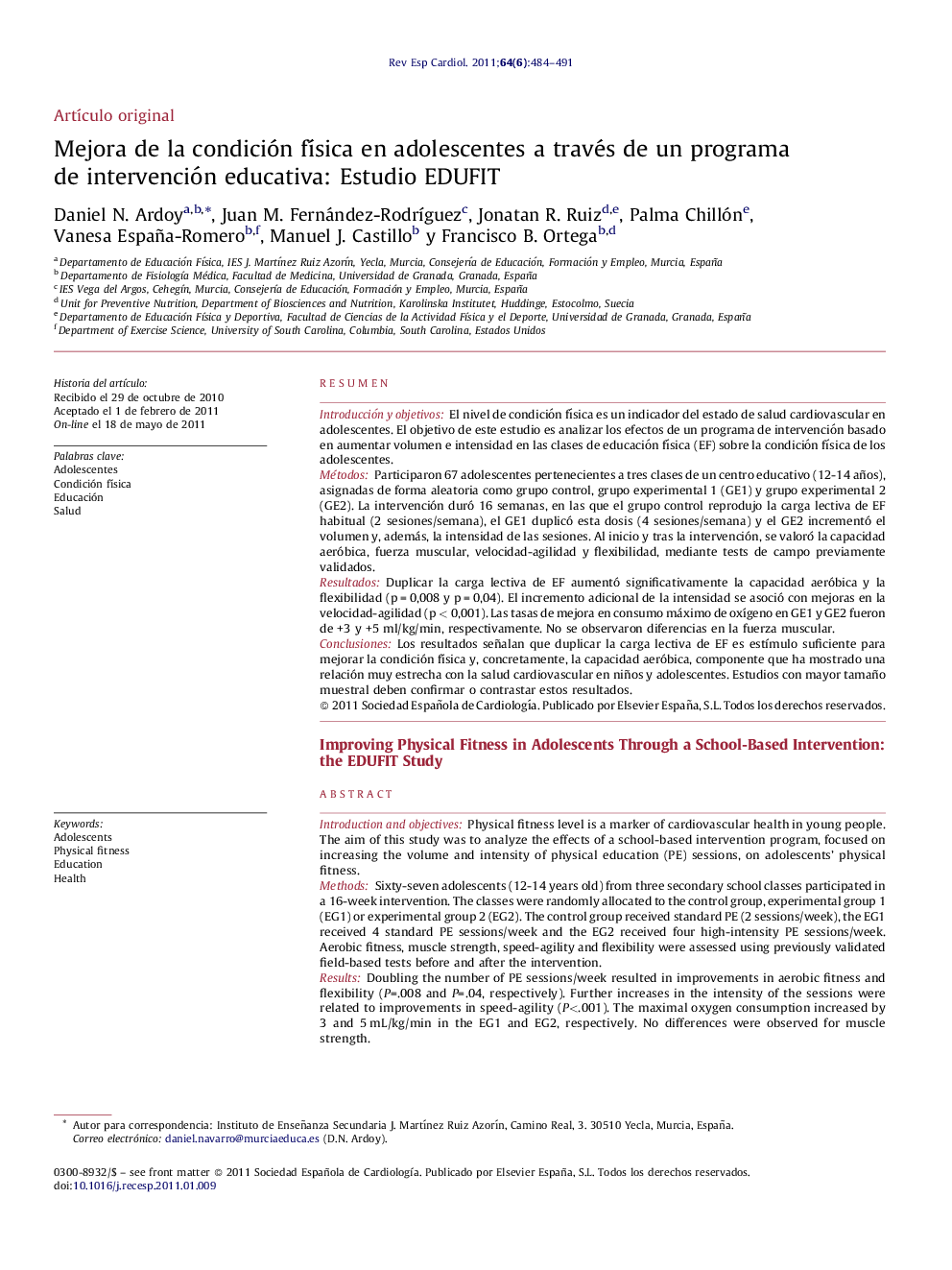| Article ID | Journal | Published Year | Pages | File Type |
|---|---|---|---|---|
| 3015282 | Revista Española de Cardiología | 2011 | 8 Pages |
ResumenIntroducción y objetivosEl nivel de condición física es un indicador del estado de salud cardiovascular en adolescentes. El objetivo de este estudio es analizar los efectos de un programa de intervención basado en aumentar volumen e intensidad en las clases de educación física (EF) sobre la condición física de los adolescentes.MétodosParticiparon 67 adolescentes pertenecientes a tres clases de un centro educativo (12-14 años), asignadas de forma aleatoria como grupo control, grupo experimental 1 (GE1) y grupo experimental 2 (GE2). La intervención duró 16 semanas, en las que el grupo control reprodujo la carga lectiva de EF habitual (2 sesiones/semana), el GE1 duplicó esta dosis (4 sesiones/semana) y el GE2 incrementó el volumen y, además, la intensidad de las sesiones. Al inicio y tras la intervención, se valoró la capacidad aeróbica, fuerza muscular, velocidad-agilidad y flexibilidad, mediante tests de campo previamente validados.ResultadosDuplicar la carga lectiva de EF aumentó significativamente la capacidad aeróbica y la flexibilidad (p = 0,008 y p = 0,04). El incremento adicional de la intensidad se asoció con mejoras en la velocidad-agilidad (p < 0,001). Las tasas de mejora en consumo máximo de oxígeno en GE1 y GE2 fueron de +3 y +5 ml/kg/min, respectivamente. No se observaron diferencias en la fuerza muscular.ConclusionesLos resultados señalan que duplicar la carga lectiva de EF es estímulo suficiente para mejorar la condición física y, concretamente, la capacidad aeróbica, componente que ha mostrado una relación muy estrecha con la salud cardiovascular en niños y adolescentes. Estudios con mayor tamaño muestral deben confirmar o contrastar estos resultados.
Introduction and objectivesPhysical fitness level is a marker of cardiovascular health in young people. The aim of this study was to analyze the effects of a school-based intervention program, focused on increasing the volume and intensity of physical education (PE) sessions, on adolescents’ physical fitness.MethodsSixty-seven adolescents (12-14 years old) from three secondary school classes participated in a 16-week intervention. The classes were randomly allocated to the control group, experimental group 1 (EG1) or experimental group 2 (EG2). The control group received standard PE (2 sessions/week), the EG1 received 4 standard PE sessions/week and the EG2 received four high-intensity PE sessions/week. Aerobic fitness, muscle strength, speed-agility and flexibility were assessed using previously validated field-based tests before and after the intervention.ResultsDoubling the number of PE sessions/week resulted in improvements in aerobic fitness and flexibility (P=.008 and P=.04, respectively). Further increases in the intensity of the sessions were related to improvements in speed-agility (P<.001). The maximal oxygen consumption increased by 3 and 5 mL/kg/min in the EG1 and EG2, respectively. No differences were observed for muscle strength.ConclusionsThe results suggest that doubling the frequency of PE sessions is a sufficient stimulus to improve physical fitness, particularly aerobic fitness, which has been shown to be a powerful indicator of cardiovascular health in children and adolescents. Future studies involving larger sample sizes should confirm or refute these findings.Full English text available from: www.revespcardiol.org
